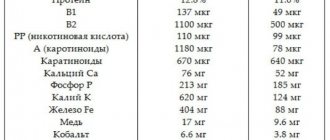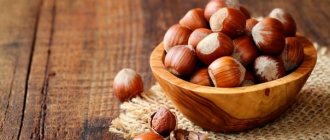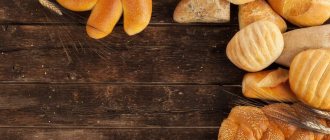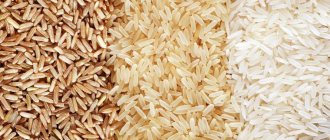Number of calories in 100 grams
The energy value of food products is determined by the amount of chemicals they contain. The calorie content of Italian Parmesan is approximately 390 kcal per 100 grams.
Due to the low water content, the mass fraction of useful elements in this cheese is much greater than in others.
Cheese calorie table
Here is a table showing the calorie content of the most popular varieties of cheese:
| Name | Number of kcal. per 100 g. |
| Adyghe | 240 |
| Bree | 291 |
| Goat milk cheese | 271 |
| Cow's milk cheese | 260 |
| Sheep's milk cheese | 298 |
| Bukovinian | 361 |
| Viola | 305 |
| Gouda | 356 |
| Dutch | 352 |
| Gruyere | 395 |
| Home | 113 |
| Dor blue | 354 |
| Camembert | 290 |
| Sausage | 271 |
| Smoked | 270 |
| Maasdam | 350 |
| Mozzarella | 240 |
| Oltermanni | 270 |
| Poshekhonsky | 350 |
| Baltic | 309 |
| Roquefort | 337 |
| Russian | 363 |
| Creamy Cremette | 270 |
| Suluguni | 290 |
| Hard Parmesan | 369 |
| Tilsiter | 334 |
| Feta | 215 |
| Fetaki | 219 |
| Fetaxa | 261 |
| Cheddar | 392 |
| Swiss | 396 |
| Estonian | 350 |
| Yaroslavsky | 350 |
Parmesan cheese: composition and nutritional value
This type of cheese contains a huge amount of valuable chemical elements.
Among them:
- protein – necessary for the renewal of skin cells, the proper formation of the muscle and skeletal system, and the production of hormones;
- calcium – responsible for the health of bones, hair, teeth, strengthens the nervous system, heart muscle;
- choline – restores damaged liver cells, improves memory and thought processes;
- B vitamins – help strengthen muscle tissue, regulate blood sugar levels, improve mental processes, and relieve unpleasant symptoms of depression.
- vitamin A – good for vision, has a positive effect on the condition of teeth, skin and hair;
- Vitamin D – ensures good blood clotting, regulates hormonal levels;
- phosphorus – promotes the favorable functioning of bone and dental tissue;
- tocopherol – stops the processes of cell wear, improves immunity, serves as a protective barrier against infections of viral and bacterial etiology;
- phylloquinone – regulates blood clotting, promotes the proper functioning of the liver, urinary system, gall bladder, strengthens connective tissue;
- sodium – normalizes the water-salt balance in the body, activates the digestive tract, improves the functioning of the nervous system;
- iron – saturates with oxygen, promotes the creation of red blood cells;
- potassium – provides elasticity and strengthens the walls of blood vessels;
- manganese – regulates the functioning of the central nervous system;
- copper – has disinfecting, hemostatic, antitumor, analgesic properties;
- magnesium – strengthens the body’s immune forces, strengthens the heart muscle;
- selenium – normalizes the functioning of the thyroid gland;
- zinc – ensures rapid healing of skin damage, has a hemostatic effect, and activates brain activity;
- fatty acids – saturate with energy, regenerate cellular metabolism.
Compound
Parmesan, as a natural product, contains a wide range of essential substances that are necessary for humans.
In particular, it contains amino acids, healthy fats, B vitamins, phosphorus and calcium. At the same time, it contains a minimal amount of cholesterol, which, in combination with useful substances, makes it indispensable for feeding children with their growing bodies, as well as for athletes whose bodies need restoration. In addition, it is also recommended for pregnant women and nursing mothers. In addition, it will be indispensable for people whose work involves heavy intellectual or physical stress. Nutrient content of Parmesan per 100 g of product [4]
| Water | 30 g |
| Squirrels | 35.75 g |
| Fats | 25 g |
| Carbohydrates | 3.22 g |
| Ash | 6.04 g |
| Calorie content | 392 kcal |
| Vitamins, mg | |
| Vitamin A (retinol) | 0,207 |
| Vitamin B1 (thiamine) | 0,039 |
| Vitamin B2 (riboflavin) | 0,332 |
| Vitamin B3 or PP | 0,271 |
| Vitamin B5 | 0,453 |
| Vitamin B6 | 0,091 |
| Vitamin B9 | 0,007 |
| Vitamin B12 | 0,0012 |
| Vitamin D | 0,0005 |
| Vitamin E | 0,22 |
| Vitamin K | 0,0017 |
| Vitamin B4 | 15,4 |
| Macroelements, mg | |
| Potassium | 92 |
| Calcium | 1184 |
| Magnesium | 44 |
| Sodium | 1175 |
| Phosphorus | 694 |
| Microelements, mg | |
| Iron | 0,82 |
| Manganese | 0,02 |
| Copper | 0,032 |
| Zinc | 2,75 |
Parmesan is also indispensable because it contains a large amount of protein - 33% (for comparison, in beef - 20%), which is also digested much faster (about 45 minutes) [5]. This substance is necessary for the body as a building element: with its help, bones and muscles are formed, hormone levels are normalized and skin cells are renewed.
The effect of parmesan on body weight during weight loss
A milk-based product contains a significant proportion of fat. But, due to its easy absorption and ability to speed up metabolic processes, as well as saturate the body for a long period of time, parmesan is included in a nutritious diet when losing weight.
You just need to follow certain recommendations:
- include cheese in the menu in small quantities for breakfast or lunch;
- Use parmesan as a healthy ingredient in various salads, sandwiches, and as an addition to pasta.
On a note! Eating parmesan in small portions will provide an opportunity for a person to lose excess weight, as well as diversify the diet menu with tasty and healthy dishes, rich in valuable chemical elements.
Parmesan production technology
Parmesan is an Italian hard cheese characterized by long ripening. Its original name is Parmigiano-Reggiano. The first written mention of it dates back to 1254 in Genoa. Cheese production is carried out annually, from early April to mid-November. The main ingredient is milk from cows grazing on the pastures of the production area.
First, the vats are heated, and then renin is added to them. Under the influence of high temperature, a curd clot is formed from it. It is divided into small particles by sharp movements.
After special treatment, the curd is placed on hemp cloth, after which it is dipped in whey. After transferring into wooden molds, excess whey is removed from the resulting curd. The next step is to distribute the cheese mixture into molds. After 4 days of aging, they are lowered into a barrel with saline solution. This is necessary for canning the product. Throughout the year, the cheese matures in a special room. Every 10 days it must be turned over and wiped with a cloth. The maturity of the cheese is determined by tapping it with a silver hammer. On the finished product you can find a mark indicating the place of its manufacture:
- Padua;
- Parma;
- Reggio Emilia;
- Bologna;
- Modena.
There should be no holes in Parmesan cheese, which are typical for cheese.
Before entering the shelves, the cheese undergoes quality control. A special commission evaluates its texture, taste, size and smell. Only after this the corresponding stamp is placed on the head of cheese.
Comment! A head of Parmesan is 70% nutrient-rich and 30% water.
Parmesan cheese: benefits and harm
Parmesan, consumed in small portions, benefits the body. Cheese has many positive properties.
These include:
- activation of brain processes;
- getting rid of anxiety, psychological depression, stress;
- improved sleep;
- normalization of the digestive system;
- renewal and ensuring the growth of healthy cells;
- acceleration of metabolic processes;
- strengthening the heart muscle and musculoskeletal system;
- saturating the intestines with beneficial bacteria;
- preventing the growth of tumors;
- ensuring the health of hair, teeth, skin, nail plates;
- improving the activity of the thyroid gland;
- elimination of anemia;
- restoration of visual functions.
Despite its usefulness, the product has a number of contraindications for use.
Cheese can be harmful to the body if used in large quantities in the diet, as well as if you have existing health problems:
- toxicosis during pregnancy;
- intestinal inflammation;
- stomach ulcer;
- allergy to dairy products;
- hypertonic disease;
- stage 3 obesity;
- kidney diseases;
- presence of stones in the bladder;
- gastritis.
Use in cooking
Naturally, real Parmesan has no extra ingredients, because, in fact, it consists only of milk and sourdough. Its rich taste is appreciated by chefs all over the world, and in Italy it is added to almost all dishes: salads, pastas, risotto and others. Due to its structure, the cheese does not form lumps when melted, leaving its ideal shape. Moreover, it is good on its own: it can be consumed in small portions, washed down with wine.
The only serious problem that gourmets face when eating Parmesan is the need to carefully cut it. Thanks to the long ripening time, it becomes very hard, but at the same time it has a rather fragile structure, so it is usually not possible to simply cut off a few pieces from its head. That is why a special knife with a round handle is used for it, which is comfortable to hold in the palm of your hand.
But the main advantage of Parmesan is the fact that it can be stored in the refrigerator for a long time - for several months.
Cheese for weight loss
Is it possible to eat cheese on a diet? Everyone has probably heard about the importance of protein in a diet. This is no coincidence, because food rich in protein quickly satisfies hunger and increases the body’s endurance, and most importantly, it reduces cravings for sweets and does not turn into fats in the body. A much-needed building component is found in cheese. Therefore, when asked whether it is possible to eat cheese on a diet, we answer that it is possible, however, with some exceptions:
- To minimize the amount of fat in the diet, you need to switch to low-calorie cheeses (up to 300 Kcal and with a fat content of no more than 20%). Nutritionists recommend light varieties of the following varieties: feta cheese, Adyghe cheese, mozzarella, brie, ricotta, tofu and feta.
- If the diet is based on counting calories, then hard and semi-hard cheeses are quite acceptable, but their consumption should be limited (eat 1-2 medium slices per day, and ideally every other day).
- Seasoned and filled varieties should be avoided.
- You need to carefully study the composition on the packaging: if there are impurities of vegetable fats, in particular palm oil, then it is better to refuse the purchase. It is also necessary to pay attention to production times and take into account that only high-quality and fresh products can benefit the body.
Sausage cheese information
Is it possible to eat sausage cheese on a diet? Despite the fact that the calorie content of sausage cheese is slightly lower than that of its hard counterparts, this product contains many different additives, so doctors recommend avoiding it during a diet. Minimum portions of high-quality sausage cheese will not harm your figure, but since it is now extremely difficult to find a naturally produced product, the question arises about its usefulness in principle, not to mention dietary nutrition.
What it is
Parmesan is an Italian hard cheese made from cow's milk.
The production technology is clearly regulated by European legislation. Compliance with it is mandatory in order to obtain the right to call the product Parmesan.
- The delicacy is prepared from April to November.
- For cheese, the settled milk obtained the previous day is taken and mixed with fresh morning milk.
- The raw materials undergo heat treatment to increase the number of lactobacilli.
- Rennet is added to the liquid to curdle it.
- The future Parmesan is first placed in special molds, where the whey is separated from it, and then left in a saline solution for a week.
- After this, its ripening begins in special temperature conditions and lasts for two to three years.
- All this time, the cheese molds are periodically turned over and tapped so that voids do not form in the heads.
One of the characteristics of Parmesan is that it cannot be cut into slices. Since this is a hard cheese, it can only be finely grated or broken off into pieces using a knife or a special metal spatula.
Interesting fact: the word “parmesan” came into use from the French language. It refers to cheese “from Parma”. But only foreigners use this name; you won’t encounter it anywhere in Italy. In its homeland it is called “Parmigiano-Reggiano”, after the names of two provinces - Parma and Reggio Emilia. Only there can real cheese with this name be produced.
You can learn more about the production process of this Italian delicacy from the video.
Types of cheese
There are three types of Parmesan:
- young, aged from one to one and a half years - it goes well with fruit and can even be a dessert;
- old, aged up to two years, most often used for preparing hot dishes;
- very old, ripening for two to three years - it has the brightest, richest taste: it is an ideal treat for cheese gourmets.
It is believed that Parmesan was invented by Italian monks in the 12th century - they needed a cheese that could be stored for a long time. It is not surprising that this delicacy does not lose its qualities even after several years: it only becomes harder, grainier, and acquires a stronger taste.
Storing cheese at home
Parmigiana can be stored in the refrigerator for several months (up to six months), and even longer in the freezer.
When storing, it is important to consider the packaging of the cheese. It must be removed from the original packaging, since it will most likely be plastic or polyethylene. And this material negatively affects cheese enzymes. Therefore, you can take parchment or wax paper and wrap the Parmesan in it. You also need to wrap it in foil on top. Such multilayer packaging will preserve the shelf life of the product in a place where the temperature will not exceed six degrees Celsius. To avoid having to worry about dating later, indicate the expiration date or date of purchase on the package.
Once opened, Parmesan can be stored in the refrigerator for up to one week.
Beneficial features
Parmigiano contains an abundance of macro- and microelements, as well as many vitamins. It contains: potassium, magnesium, calcium, phosphorus, sodium, copper, iron, manganese, selenium, zinc. Among the useful vitamins, we can note: vitamin A, K, D, B1, B2, E, PP (or B3), B5, B6, folic acid, choline, B12.
In addition to the average calorie content of Parmesan cheese, it has high nutritional value and is rich in natural protein and essential amino acids. Another feature of its physicochemical composition is the presence of two important acids: isovaleric and butyryl. The first acid works in the body as a sedative, it calms. And the second promotes the breakdown of fatty acids and stops the development of cancer cells in the colon.
All this indicates that this variety brings maximum benefits to the human diet.
Among the disadvantages, it can be noted that Parmesan contains a lot of salt (monosodium glutamate), which affects the appearance of migraines (with a tendency to headaches) and affects the functioning of the kidneys, blood vessels, and heart. And also people prone to vascular diseases and prone to swelling should minimize the amount of cheese consumed. For healthy people, it is enough to follow the norm of consumption of this product.











